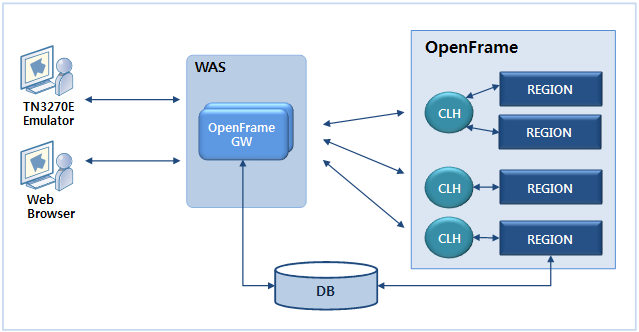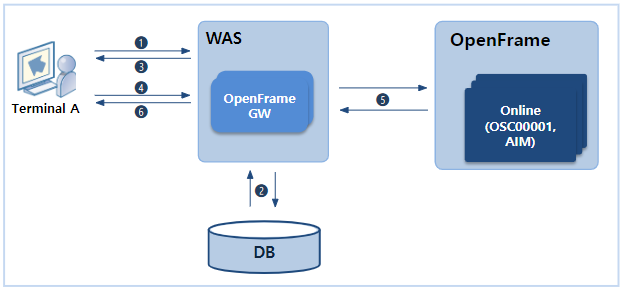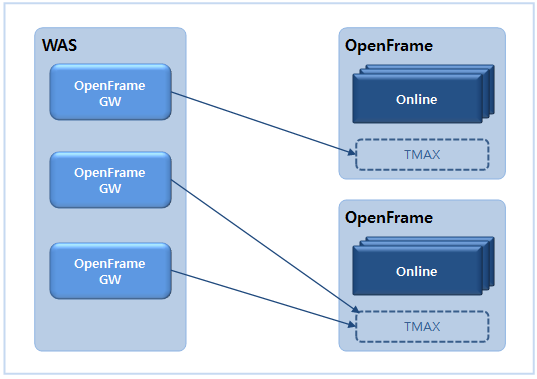Introduction to OpenFrame GW
This chapter briefly introduces OpenFrame GW and its key features.
1. Overview
OpenFrame GW is one of many products that make up OpenFrame, a Mainframe rehosting solution. OpenFrame GW monitors and manages multiple number of 3270 terminals in real time, and is responsible for data processing, transaction management, and terminal management between online products (OSC, OSI, and AIM) and terminals.
Users can communicate with OpenFrame by using the 3270 protocol terminal and the web protocol terminal provided in OpenFrame GW.
OpenFrame GW performs the following:
-
Manages connections between application programs and terminals.
-
Transmits data between application programs and terminals.
-
Shares terminal between application programs.
-
Allocates LU name automatically for terminal access
-
Monitors and manages networks.
-
Provides a 3270 emulator via web browser.
2. Functions
OpenFrame GW manages communication between networks, and supports the following functions:
-
Startup and shutdown of terminals and access control
-
Can disconnect from terminals through an application program and can connect to terminals using the configuration settings.
-
Controls terminal connections according to the allocated resources.
-
-
Dynamic resource management
-
Reads an updated resource from the database when it is modified.
-
Controls terminal connections in real time via dynamic resource management.
-
-
Resource sharing through database
-
Shares available application servers and related resources through the database.
-
Manages and shares information about connected terminals and OpenFrame GW through the database.
-
-
I/O operation
-
Manages data transmissions between application programs and terminals. Terminals are connected via socket and web communication, and communication with application programs is processed through Tmax.
-
Uses the 3270 and Tmax protocols to convert data and perform I/O.
-
-
Convenience and reliability
-
Reduces the impact of network communication errors.
-
Enables application programs to maintain data format.
-
-
Transaction scheduling
-
Schedules transactions for application programs.
-
-
WebTerminal
-
Provides both a WebTerminal and 3270 protocol terminal.
-
Can continue to use 3270 data protocol internally, like a 3270 protocol emulator, in OpenFrame GW through the WebTerminal.
-
-
Communication with multiple terminals and servers
-
Connects to multiple terminals and manages the connections.
-
Connects to multiple application servers, and manages each connection allowing servers to communicate with each other.
-
3. Architecture
OpenFrame GW is configured as a web server on top of a web application server. The database (Tibero) stores information about connected terminals and online regions (OSC, OSI, AIM, and etc.). The online regions of OpenFrame can be accessed through Tmax’s CLH, and resources can be shared through a database. Since Tmax handles connection scheduling, terminal connections can be established within the range allowed by Tmax regardless of the number of connection requests.

-
WAS (Web Application Server)
OpenFrame GW runs on top of a web application server (JEUS).
-
DB
Stores information about connected terminals, VTAM and online regions.
-
Connected gateway
Stores the currently active OpenFrame GW information.
-
Connected terminals
Stores information of the terminals connected to each gateway. This provides the function of not allowing access with the same LU name, and helps to deal with the problems, occurring in operation, by providing a list of currently connected terminals.
-
LU automatic allocation
Stores VTAM resource information defined for LUs that can be automatically allocated by each gateway (PORT). For more information, refer to LU Automatic Allocation.
-
Online Region
Stores the information of the currently activated online regions (OSCOIVP1, AIM, OSI, …).
-
-
CLH
Tmax client handler that mediates between the client and server. It requests services to a transaction processing server, and connects and manages servers. It sends client requests to a server by using a function, such as tpcall.
-
REGION
Executes application programs, and communicates with OpenFrame GW via CLH.
-
Web browser
Provides a UI that accepts user input and outputs results using the reply received from the web application server (JEUS).
4. Operation
The following diagram describes the process of executing a transaction in an online region by logging in to a 3270 terminal.

-
Terminal A connects to OpenFrame GW, and then attempts to log into an online region. (Try with region server name for OSC, OSI, and procedure name for AIM.)
-
OpenFrame GW connects to the database and authenticates terminal A in the database.
-
If Terminal A is registered in the database, login is permitted.
-
After logging in, the user enters a transaction name.
-
OpenFrame GW sends the transaction to the online region, and receives the execution result.
-
Data received from the online region is analyzed, and the result is displayed on Terminal A.
5. Connection with JEUS
Since OpenFrame GW runs on a web application server (JEUS) and multiple servers can exist on a single web application server, OpenFrame GW can run on one or more servers on a web application server. This enables running multiple OpenFrame GWs on a single web application server, and the OpenFrame GWs can connect to the same or different OpenFrame systems.

|
For more information about web application servers, refer to JEUS Domain Guide. |
6. Character Set Conversion between OpenFrame GW and OpenFrame
OpenFrame GW communicates with the 3270 emulator as well as the web terminal, and provides a function to convert the message processed in OpenFrame using the appropriate character set (CPM) and then deliver it.
3270 emulator basically transmits 3270 data to OpenFrame GW in EBCDIC characters suitable for each country’s characters, and the web terminal transmits data in ASCII characters. Since OpenFrame can send and receive data only with EBCDIC characters, a web terminal needs to convert ASCII characters to EBCDIC characters, and OpenFrame GW handles this using a predefined character set called CPM.
The following is a description of the process of a web terminal sending and receiving data to and from OpenFrame through OpenFrame GW using the Japanese character set (ASCEBCJP:EBCASCJP).

-
Transmission process
The web terminal transmits data in JSON format to OpenFrame GW in UTF-16 encoding. In order to finally convert data into EBCDIC format, OpenFrame GW first converts UTF-16 encoded data into ASCII format. At this time, the data expressed in Unicode is converted into ASCII format using the IBM943.ucm character set. And the data converted to ASCII format is converted back to EBCDIC format using the ASCEBCJP.cpm character set.
-
Response process
The data transmitted to OpenFrame GW in EBCDIC format must be converted by UTF-16 encoding to be transmitted back to the web terminal. At this time, using IBM290_300.ucm, EBCDIC format data is converted into Unicode format.